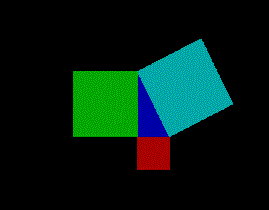User:EllenTsang
Hi I'm Ellen and I am in 1st year Commerce.
I prefer to say I am from Hong Kong although I do have Canadian citizenship. I am planning to major in Marketing, with a minor in International Business. My favourite hobby is singing karaoke and I love Korean and Japanese music. I like Statistics but this is unfortunately not in our MATH 110 course, aww.
I like pi(e).
Main Links:
Course:MATH110/003/Teams/Zurich
Course:MATH110/003/Groups/Group 09
Pythagorean Theorem
Here is shown the animated proof of the Pythagorean Theorem.
To prove that, when a and b are the two sides of a right-angled triangle and c is the hypotenuse:

The area of the middle-sized square, , is cut into congruent quadrilaterals, as shown in the animation.
Then the quadrilaterals are rearranged and shifted to the largest square, .
Lastly, the smallest square, , is translated to fit into the remaining middle area of .
Hence, this proves that the sum of the squares of the two smaller sides equals the square of the largest side.
Applications of Calculus
Calculus is essential for a wide variety of careers. For example, differential calculus can be used in Biology to find the rate of growth of Bacteria over time given different constraints and variables such as food and temperature. Integral calculus could be used to calculate the amount of material required to construct a curved dome. At the present, since I am taking a Commerce degree, I want to focus on the applications of calculus in the Business world. The uses of calculus in Business are extensive, for instance, optimization i.e. how to maximize profits by optimizing operations to attain maximum sales and minimum costs. Calculus could also be used to find marginal figures such as marginal cost and marginal revenues.
An Example of an Application of Calculus in Business
A factory is capable of producing 60,000 phones in a day and the total daily cost of producing x phones in a day is given by,
The question is:
How many phones per day should they produce in order to minimize production costs?
Solution
Here we need to minimize the cost subject to the constraint that x must be in the range:
In this case, the cost function is not continuous at the left endpoint and so we won’t be able to just plug critical points and endpoints into the cost function to find the minimum value.
First, we must find the first couple of derivatives of the cost function.
The critical points of the cost function are:
In this case, the negative value doesn’t make any sense so we can ignore it.
Hence, we have a single critical point in the range of possible solutions: 50,000.
Now, as long as , the second derivative is positive and so, in the range of possible solutions the function is always concave up and so producing 50,000 phones will yield the absolute minimum production cost.
I believe that no matter in which occupational field, calculus plays an indispensable role in the success of its operations.






